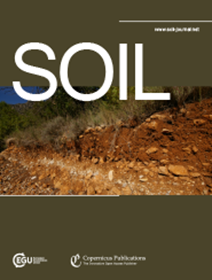Soil degradation assessment across tropical grassland of Western Kenya
IF 4.3
2区 农林科学
Q1 SOIL SCIENCE
引用次数: 0
Abstract
Abstract. Soils across sub-Saharan Africa are exposed to extensive degradation, reducing their ability to produce crops and support livestock. While there has been a significant research effort focussing on soil degradation in sub-Saharan croplands, less research effort had been directed towards grasslands. Here, we tested the effectiveness of remote sensing to classify the soil degradation status of smallholder grazing lands. Focussing on grasslands used by smallholders in the districts of Nyando and Kuresoi in Western Kenya, we first used remote sensing (RS) to classify grasslands as either equilibrium, transition or degraded, and then tested how this classification related to measured soil parameters indicative of soil degradation. We then used this classification, which was based on a temporal analysis of Normalised Differential Vegetation Index (NDVI), Enhanced Vegetation Index (EVI) and Normalised Differential Water Index (NDWI) between 2013 and 2018, to identify 90 field sites across the two districts, which we then sampled and analysed for a range of physical, chemical and biological soil properties. Only soil microbial biomass carbon (C) showed consistent alignment with the RS classification, although there was some overlap with other soil parameters at one or other of the sites. To group the sites using the soil parameters, which we split by district and into stable and transient soil variables, K-means clustering was undertaken. Two clusters were produced. One of the clusters included sites with higher levels of C, nitrogen (N), phosphorus (P) and pH, that aligned well with the RS classification at Kuresoi, with seven out of ten equilibrium sites being assigned to this cluster. The other cluster, in Nyando, had high soil C and P, but low pH and relatively low soil bulk density, and corresponded to 12 out of the 16 equilibrium sites. Overall, our results suggest that while the use of RS methods for classifying degraded grasslands and the soils supporting them does have significant advantages in terms of time and costs over field survey, supplementing these methods with a limited set of soil parameters related to nutrient cycling, such as microbial biomass C, soil P, percent C and N, and soil pH, could enhance our ability to to identify degraded soils and target restoration efforts.肯尼亚西部热带草原土壤退化评价
摘要。撒哈拉以南非洲的土壤普遍退化,降低了其生产作物和饲养牲畜的能力。虽然对撒哈拉以南农田的土壤退化进行了大量的研究,但对草原的研究较少。本文对遥感技术在小农牧区土壤退化状况分类中的有效性进行了验证。以肯尼亚西部Nyando和Kuresoi地区小农使用的草地为研究对象,我们首先使用遥感(RS)对草地进行了平衡、过渡和退化分类,然后测试了这种分类与指示土壤退化的测量土壤参数之间的关系。然后,我们使用这种分类,该分类基于2013年至2018年间标准化差异植被指数(NDVI),增强植被指数(EVI)和标准化差异水指数(NDWI)的时间分析,以确定两个地区的90个野外站点,然后我们对一系列物理,化学和生物土壤特性进行采样和分析。只有土壤微生物生物量碳(C)与RS分类一致,尽管在一个或另一个地点与其他土壤参数有一些重叠。为了利用土壤参数对站点进行分组,我们将土壤参数按区域划分为稳定和瞬态土壤变量,进行了K-means聚类。产生了两组。其中一个簇包括C、氮、磷和pH水平较高的位点,这与Kuresoi的RS分类非常吻合,10个平衡位点中有7个被分配到这个簇。另一个群落位于Nyando,具有较高的土壤C和P,但pH值较低,土壤容重相对较低,对应16个平衡点中的12个。总体而言,我们的研究结果表明,虽然使用RS方法对退化草地及其土壤进行分类在时间和成本方面确实比实地调查具有显着优势,但在这些方法的基础上补充一组有限的与养分循环相关的土壤参数,如微生物生物量C、土壤P、百分比C和N以及土壤pH,可以提高我们识别退化土壤和目标恢复工作的能力。
本文章由计算机程序翻译,如有差异,请以英文原文为准。
求助全文
约1分钟内获得全文
求助全文
来源期刊

Soil
Agricultural and Biological Sciences-Soil Science
CiteScore
10.80
自引率
2.90%
发文量
44
审稿时长
30 weeks
期刊介绍:
SOIL is an international scientific journal dedicated to the publication and discussion of high-quality research in the field of soil system sciences.
SOIL is at the interface between the atmosphere, lithosphere, hydrosphere, and biosphere. SOIL publishes scientific research that contributes to understanding the soil system and its interaction with humans and the entire Earth system. The scope of the journal includes all topics that fall within the study of soil science as a discipline, with an emphasis on studies that integrate soil science with other sciences (hydrology, agronomy, socio-economics, health sciences, atmospheric sciences, etc.).
 求助内容:
求助内容: 应助结果提醒方式:
应助结果提醒方式:


